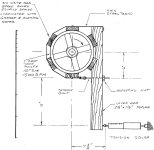a motor that opposes rotation IS a generator. shorting an alternator would make it a 0% efficient alternator, that would convert 100% of mechanical power into heat. considering electric motors under nominal load is probably around 90%+ efficient, running it with 0% efficiency means heat x10 so you would only be able to sustain a load that is 10% of the rating of the motor. also you would have zero control on the current generated (and the resisting torque associated) so anything stronger will rev very quickly and anything weaker won't be able to rev at all. basically zero advantage vs simple inertia Dyno. when you make a Dyno you want it to have the widest range possibleto be clear I'm not intending to use the alternator as an alternator. I would convert it to a motor that would then oppose the motor under test. I can make the alternator apply braking force via magnetism.
Basically adding resistive electrical loads to the alternator would just approach the same thing as shorting the alternator phase wires to each other. This does cause mechanical resistance but not enough I'm afraid.
DIY Motor Dyno/load?
- Thread starter shaman
- Start date


